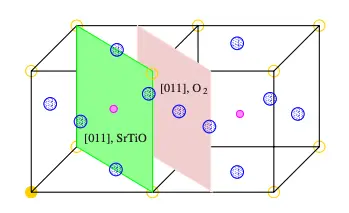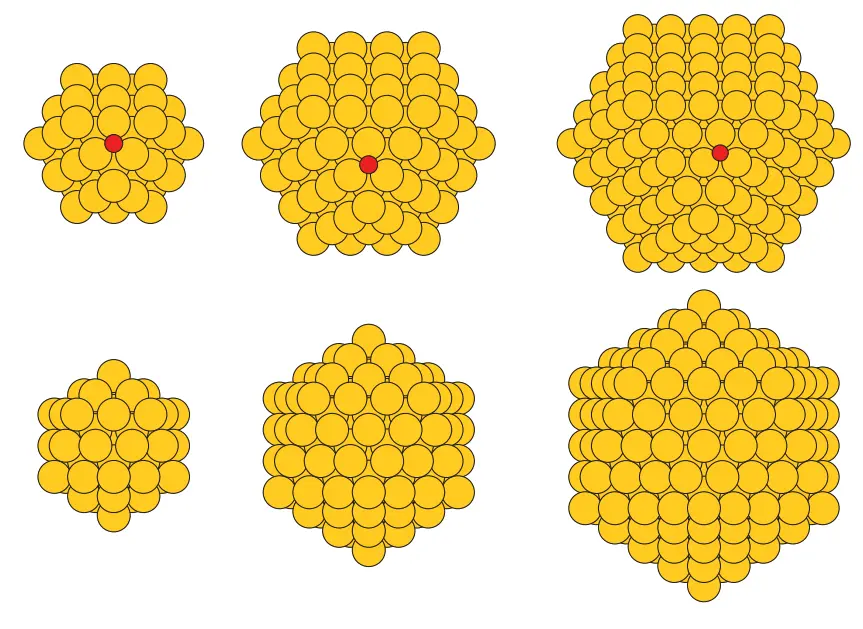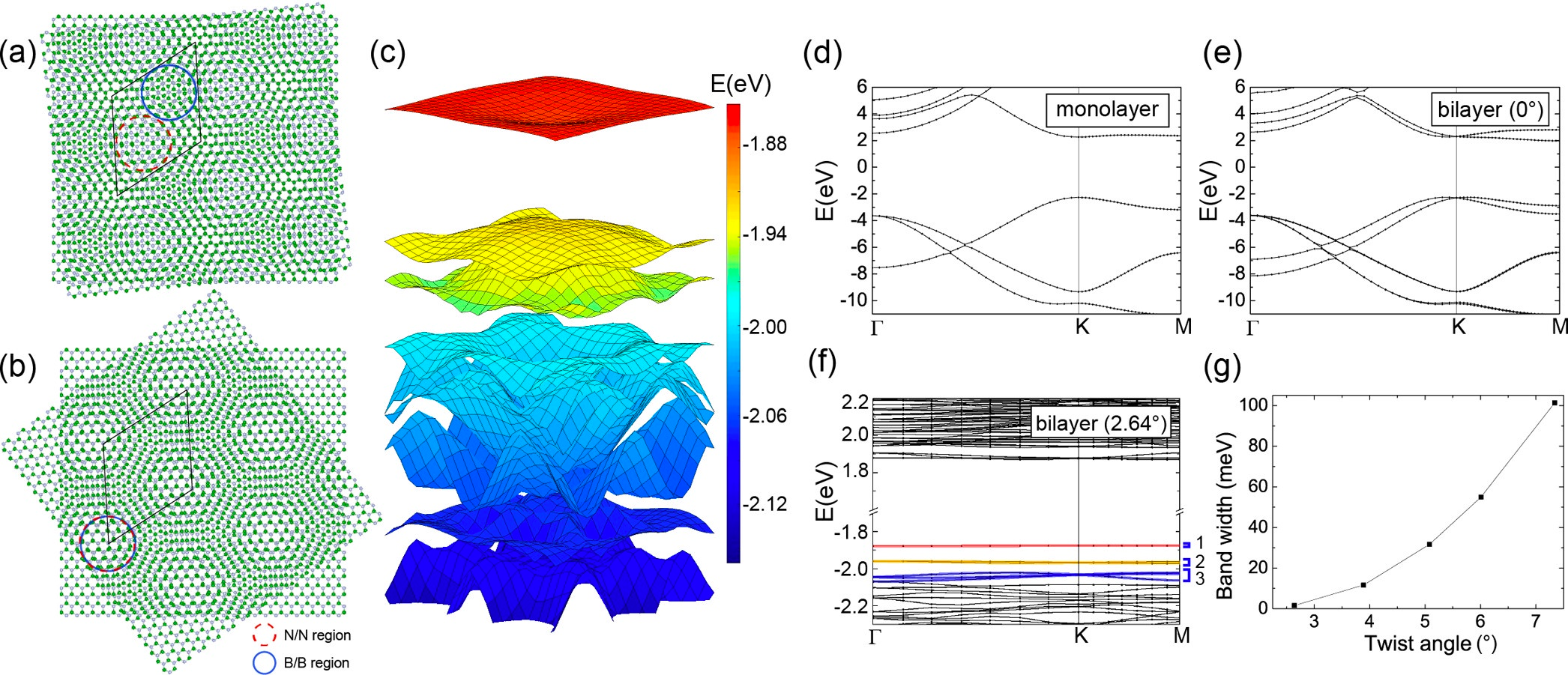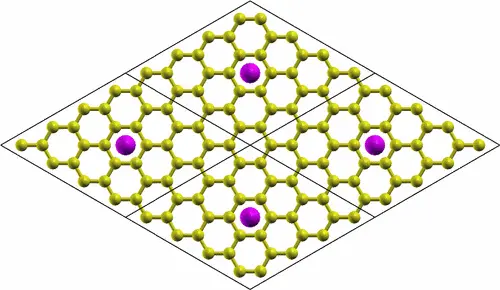Specific Materials Examples¶
This document contains links to the tutorials that demonstrate how to reproduce material structures from published scientific manuscripts. Each entry lists the tutorial name and the corresponding manuscript reference.
1. Single-Material Structures¶
1.1. 2D Structures¶
1.1.1. SrTiO3 Slab¶
DOI: 10.1103/PhysRevB.77.195408 12

1.2. 0D Structures¶
1.2.1. Gold Nanoclusters¶
DOI: 10.1103/PhysRevB.84.245429. 3

2. Multi-Material Structures¶
2.1. Interfaces¶
2.1.1. Interface between Graphene and h-BN¶

2.1.2. Interface between Graphene and SiO2 (alpha-quartz)¶
DOI: 10.1103/PhysRevB.78.115404
![]()
2.1.3. Interface between Copper and SiO2 (Cristobalite)¶
DOI: 10.1103/PhysRevB.83.115327 5.

2.1.4. High-k Metal Gate Stack (Si/SiO2/HfO2/TiN)¶
QuantumATK tutorial: High-k Metal Gate Stack Builder 67
![]()
2.2. Twisted Interfaces¶
2.2.1. Twisted Bilayer h-BN nanoribbons¶
DOI: 10.1021/acs.nanolett.9b00986 8

2.2.2. Twisted Bilayer MoS2 commensurate lattices¶

3. Defects¶
3.1. Point Defects¶
3.1.1. Substitutional Point Defects in Graphene¶
DOI: 10.1103/PhysRevB.84.245446

3.1.2. Vacancy-Substitution Pair Defects in GaN¶
DOI: 10.1103/PhysRevB.93.165207. 11

3.1.3. Vacancy Point Defect in h-BN¶
DOI: 10.1038/s41524-022-00730-w

3.1.4. Interstitial Point Defect in SnO¶
DOI: 10.1103/PhysRevB.74.195128. 121314

3.2. Surface Defects¶
3.2.1. Island Surface Defect Formation in TiN¶
DOI: 10.1103/PhysRevB.97.035406. 15

3.2.2. Step Surface Defect on Pt(111)¶
DOI: 10.1016/s0039-6028(02)01908-8. 16

3.2.3. Adatom Surface Defects on Graphene¶
DOI: 10.1103/PhysRevB.77.235430

3.3. Planar Defects¶
3.3.1. Grain Boundary in FCC Metals (Copper)¶

3.3.2. Grain Boundary (2D) in h-BN¶
DOI: 10.1021/acs.nanolett.5b01852

4. Passivation¶
4.1. Edge Passivation¶
4.1.1. H-Passivated Silicon Nanowire¶
DOI: 10.1103/PhysRevB.76.035305 18
![]()
4.2. Surface Passivation¶
4.2.1. H-Passivated Silicon (100) Surface¶
DOI: 10.1103/PhysRevB.57.13295. 192021
![]()
5. Perturbations¶
5.1. Ripples¶
5.1.1. Ripple perturbation of a Graphene sheet¶
DOI: 10.1209/0295-5075/85/46002. 222324

6. Other¶
6.1. Interface Optimization¶
6.1.1. Gr/Ni(111) Interface Optimization¶
DOI: 10.1039/c3nr05279f. 252627

6.1.2. Pt Adatoms Island on MoS2¶
DOI: 10.1021/cg5013395. 2829303132

References¶
-
R. I. Eglitis and David Vanderbilt. First-principles calculations of atomic and electronic structure of srtio3 (001) and (011) surfaces. Phys. Rev. B, 77:195408, May 2008. URL: https://link.aps.org/doi/10.1103/PhysRevB.77.195408. ↩
-
Atashi B. Mukhopadhyay, Javier F. Sanz, and Charles B. Musgrave. First-principles calculations of structural and electronic properties of monoclinic hafnia surfaces. Phys. Rev. B, 73:115330, Mar 2006. URL: https://link.aps.org/doi/10.1103/PhysRevB.73.115330. ↩
-
Ask Hjorth Larsen, Jesper Kleis, Kristian Sommer Thygesen, Jens K. Nørskov, and Karsten Wedel Jacobsen. Electronic shell structure and chemisorption on gold nanoparticles. Phys. Rev. B, 84(24):245429, 2011. URL: https://doi.org/10.1103/PhysRevB.84.245429. ↩
-
Allan H. MacDonald & Shaffique Adam Jeil Jung, Ashley M. DaSilva. Origin of the band gap in graphene on hexagonal boron nitride. Nature Communications, 6:6308, 2015. URL: https://doi.org/10.1038/ncomms7308. ↩
-
T.-R. Shan, B. D. Devine, S. R. Phillpot, and S. B. Sinnott. Molecular dynamics study of the adhesion of cu/sio2interfaces using a variable-charge interatomic potential. Physical Review B, 2011. URL: https://doi.org/10.1103/PhysRevB.83.115327. ↩
-
D A Muller, N Nakagawa, A Ohtomo, J L Grazul, and H Y Hwang. The electronic structure at the atomic scale of ultrathin gate oxides. Nature, 399:758–761, 1999. URL: https://doi.org/10.1038/21667. ↩
-
J Robertson. High dielectric constant gate oxides for metal oxide si transistors. Reports on Progress in Physics, 69:327, 2006. URL: https://doi.org/10.1088/0034-4885/69/2/R02. ↩
-
Lede Xian, Dante M. Kennes, Nicolas Tancogne-Dejean, Massimo Altarelli, and Angel Rubio. Multiflat bands and strong correlations in twisted bilayer boron nitride: doping-induced correlated insulator and superconductor. Phys. Rev. Lett., 125:086402, 2020. URL: https://doi.org/10.1021/acs.nanolett.9b00986. ↩
-
Kaihui Liu, Liming Zhang, Ting Cao, Chenhao Jin, Diana Qiu, Qin Zhou, Alex Zettl, Peidong Yang, Steve G. Louie, and Feng Wang. Evolution of interlayer coupling in twisted molybdenum disulfide bilayers. Nature Communications, 5:4966, 2014. URL: https://doi.org/10.1038/ncomms5966, doi:10.1038/ncomms5966. ↩
-
Y. Cao, V. Fatemi, S. Fang, and et al. Unconventional superconductivity in magic-angle graphene superlattices. Nature, 556:43–50, 2018. URL: https://doi.org/10.1038/nature26160. ↩
-
Giacomo Miceli and Alfredo Pasquarello. Self-compensation due to point defects in mg-doped gan. Physical Review B, 93:165207, 2016. URL: https://link.aps.org/doi/10.1103/PhysRevB.93.165207. ↩
-
A. Togo, F. Oba, and I. Tanaka. First-principles calculations of native defects in tin monoxide. Physical Review B, 74(19):195128, 2006. URL: https://doi.org/10.1103/PhysRevB.74.195128. ↩
-
H. Wang, A. Chroneos, C. A. Londos, E. N. Sgourou, and U. Schwingenschlögl. Carbon related defects in irradiated silicon revisited. Scientific Reports, 4:4909, 2014. URL: https://doi.org/10.1038/srep04909. ↩
-
Sutassana Na-Phattalung, M. F. Smith, Kwiseon Kim, Mao-Hua Du, Su-Huai Wei, S. B. Zhang, and Sukit Limpijumnong. First-principles study of native defects in anatase tio2. Physical Review B, 73:125205, 2006. URL: https://doi.org/10.1103/PhysRevB.73.125205. ↩
-
D. G. Sangiovanni, A. B. Mei, D. Edström, L. Hultman, V. Chirita, I. Petrov, and J. E. Greene. Effects of surface vibrations on interlayer mass transport: ab initio molecular dynamics investigation of ti adatom descent pathways and rates from tin/tin(001) islands. Physical Review B, 97:035406, 2018. URL: https://link.aps.org/doi/10.1103/PhysRevB.97.035406. ↩
-
Z. Šljivančanin and B. Hammer. Oxygen dissociation at close-packed Pt terraces, Pt steps, and Ag-covered Pt steps studied with density functional theory. Surface Science, 515(1):235–244, 2002. URL: https://doi.org/10.1016/s0039-6028(02)01908-8. ↩
-
Timofey Frolov, David L Olmsted, Mark Asta, and Yuri Mishin. Structural phase transformations in metallic grain boundaries. Nature Communications, 4:1899, 2013. URL: https://doi.org/10.1038/ncomms2924. ↩
-
B. Aradi, L. E. Ramos, P. Deák, Th. Köhler, F. Bechstedt, R. Q. Zhang, and Th. Frauenheim. Theoretical study of the chemical gap tuning in silicon nanowires. Phys. Rev. B, 76(3):035305, 2007. URL: https://doi.org/10.1103/PhysRevB.76.035305. ↩
-
U. Hansen and P. Vogl. Hydrogen passivation of silicon surfaces: a classical molecular-dynamics study. Physical Review B, 57(20):13295–13304, 1998. URL: https://doi.org/10.1103/physrevb.57.13295. ↩
-
J. E. Northrup. Structure of si(100)h: dependence on the h chemical potential. Physical Review B, 44(3):1419–1422, 1991. URL: https://doi.org/10.1103/physrevb.44.1419. ↩
-
J. J. Boland. Structure of the h‐saturated si(100) surface. Physical Review Letters, 65(26):3325–3328, 1990. URL: https://doi.org/10.1103/physrevlett.65.3325. ↩
-
R. C. Thompson-Flagg, M. J. B. Moura, and M. Marder. Rippling of graphene. EPL (Europhysics Letters), 85(4):46002, 2009. URL: https://doi.org/10.1209/0295-5075/85/46002. ↩
-
A. Fasolino, J. H. Los, and M. I. Katsnelson. Intrinsic ripples in graphene. Nature Materials, 6:858–861, 2007. URL: https://doi.org/10.1038/nmat2011. ↩
-
L. A. Openov and A. I. Podlivaev. Interaction of the stone-wales defects in graphene. Physics of the Solid State, 52(1):2010, 2010. URL: https://doi.org/10.1134/S1063783415070240. ↩
-
Arjun Dahal and Matthias Batzill. Graphene–nickel interfaces: a review. Nanoscale, 6:2548–2562, 2014. URL: https://doi.org/10.1039/C3NR05279F. ↩
-
Y. Gamo, A. Nagashima, M. Wakabayashi, M. Terai, and C. Oshima. Atomic structure of monolayer graphite formed on ni(111). Surface Science, 374(1-3):61–64, 1997. URL: https://www.sciencedirect.com/science/article/abs/pii/S0039602896007856. ↩
-
G. Bertoni, L. Calmels, A. Altibelli, and V. Serin. First-principles calculation of the electronic structure and eels spectra at the graphene/ni(111) interface. Physical Review B, 2004. URL: https://journals.aps.org/prb/abstract/10.1103/PhysRevB.71.075402. ↩
-
W. A. Saidi. Density functional theory study of nucleation and growth of pt nanoparticles on mos2(001) surface. Crystal Growth & Design, 15(2):642–652, 2015. URL: https://doi.org/10.1021/cg5013395. ↩
-
M. Jiao, W. Song, H.-J. Qian, Y. Wang, Z. Wu, S. Irle, and K. Morokuma. Qm/md studies on graphene growth from small islands on the ni(111) surface. Nanoscale, 8(5):3067–3074, 2016. URL: https://doi.org/10.1039/c5nr07680c. ↩
-
Kristen A. Fichthorn and Matthias Scheffler. Island nucleation in thin-film epitaxy: a first-principles investigation. Phys. Rev. Lett., 84:5371, 2000. URL: https://link.aps.org/doi/10.1103/PhysRevLett.84.5371. ↩
-
Jörg Neugebauer and Matthias Scheffler. Mechanisms of island formation of alkali-metal adsorbates on al(111). Phys. Rev. Lett., 71:577, 1993. URL: https://link.aps.org/doi/10.1103/PhysRevLett.71.577. ↩
-
Mahbube Hortamani, Peter Kratzer, and Matthias Scheffler. Density-functional study of mn monosilicide on the si(111) surface: film formation versus island nucleation. Phys. Rev. B, 76:235426, 2007. URL: https://link.aps.org/doi/10.1103/PhysRevB.76.235426. ↩